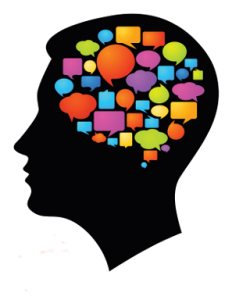( Updated 4/25/2025 )
At one point, Wilder seems to argue that since individual neurons fire in one direction, that the entire right-hemisphere of the brain runs with “one-way traffic” and thus functions in a linear fashion (beginning from the attachment center). This is most certainly an unfounded leap, and it is doubtful that any qualified neurologist would agree with such a theory (see update below).
 Our brain is a highly complex system in which every part impacts nearly every other part. And this is fairly easy to demonstrate. How else could we calm ourselves from the inside when we get upset by something scary on the outside? One-way traffic would imply that we have to fix our circumstances (i.e. neural input) in order to calm down. Other examples: Anyone can elicit powerful emotions by telling a story created by rational thought, or by consciously directing attention to certain ideas, memories, or situations. We can even trigger phobias by bringing to mind the necessary conditions. This is clearly multi-directional processing at work. Our brain even has a major fiber network (corpus callosum) that acts like a massive two-way super highway between the two sides of the brain so that we can integrate our thoughts, feelings, words and experiences.
Our brain is a highly complex system in which every part impacts nearly every other part. And this is fairly easy to demonstrate. How else could we calm ourselves from the inside when we get upset by something scary on the outside? One-way traffic would imply that we have to fix our circumstances (i.e. neural input) in order to calm down. Other examples: Anyone can elicit powerful emotions by telling a story created by rational thought, or by consciously directing attention to certain ideas, memories, or situations. We can even trigger phobias by bringing to mind the necessary conditions. This is clearly multi-directional processing at work. Our brain even has a major fiber network (corpus callosum) that acts like a massive two-way super highway between the two sides of the brain so that we can integrate our thoughts, feelings, words and experiences.
Wilder also goes to great lengths to describe what he calls fast-track and slow-track processes in our brain (see Fast-Slow Distraction). The slow-track (supposedly left-brain functions) is where we process information, manage language, and carry out logical reasoning. In contrast, the fast-track (supposedly right-brain functions) works with images, implicit memory, emotions, and generates reactions to events and people around us. Furthermore, we are told that the fast track runs a bit faster (5 cycles per second?) than the slow track (4 cycles per second?). His theory is that many people rely on information to drive their life (slow), which can never keep up with what is going on in the fast track; which is why we react before we think. So we need to train the fast track instead. Sounds plausible on the surface.
But the problem here is that the brain is far more integrated that his model implies. Every thought is connect to emotions; every emotion evokes thoughts. Both aspects of the mind work together and get trained together. So yes, depending on education alone to foster spiritual growth has been a big mistake, because we need to train the whole mind — just as Wilder would never attempt to train our emotional side without first explaining all of his reasoning in a book. But none of this is news to anyone who has understood and engaged in spiritual practices as taught by spiritual leaders for thousands of years! They have always known that stuffing our heads with information was insufficient. And if we slow down enough to read Dallas Willard carefully, this is precisely his point.
Wilder is clearly trying to distance himself from Dallas, but his process is completely unsupportable: he first distorts the teachings of Dallas, and he then uses a questionable approach to brain science in order to create the impression that he has discovered something Dallas overlooked. But all he has really accomplished is to confuse the reader about the true nature of spiritual formation and the amazing contributions of Dallas.
Our brains do not put things into boxes and connect them in some linear fashion. Our mind is a complex network that integrates both left and right hemispheres, both prefrontal cortex thinking and “back brain” feeling, along with archetypical icons, life issues, relationships and events, etc. And it is through that total integration of our mind that we make sense of reality and who we are and how to live. Within that process, our bonding and attachment have tremendous power. And all of this is completely in line with how Dallas helped to forge a trail that leads us into deeper relationship with God and foster spiritual growth.
Update: A neurologist weighs in on Wilder’s theories
A neurologist with a PHD in neuroscience has looked at Jim Wilder’s ideas about how the brain works, and concluded that much of it is just plain wrong. That single assessment calls into question nearly everything Wilder teaches about the brain. In fact, all one needs to do is Google something along the lines of, ‘is the common separation of left and right brain true?’ and the AI will respond with hundreds of sources that debunk the whole “left-brain/right-brain” theory. Most neuroscientists discarded this theory years ago. So there is no such thing as a “right hemisphere control center” or a “pain processing pathway” that LMW has been teaching for the last two decades.
But even more serious, this calls into question whatever “theology” that Wilder claims to draw from his “science.”
You can read more about this in Stan Wallace’s initial critique of Renovated. Please see the post about Stan’s article here.
That all makes sense to me.